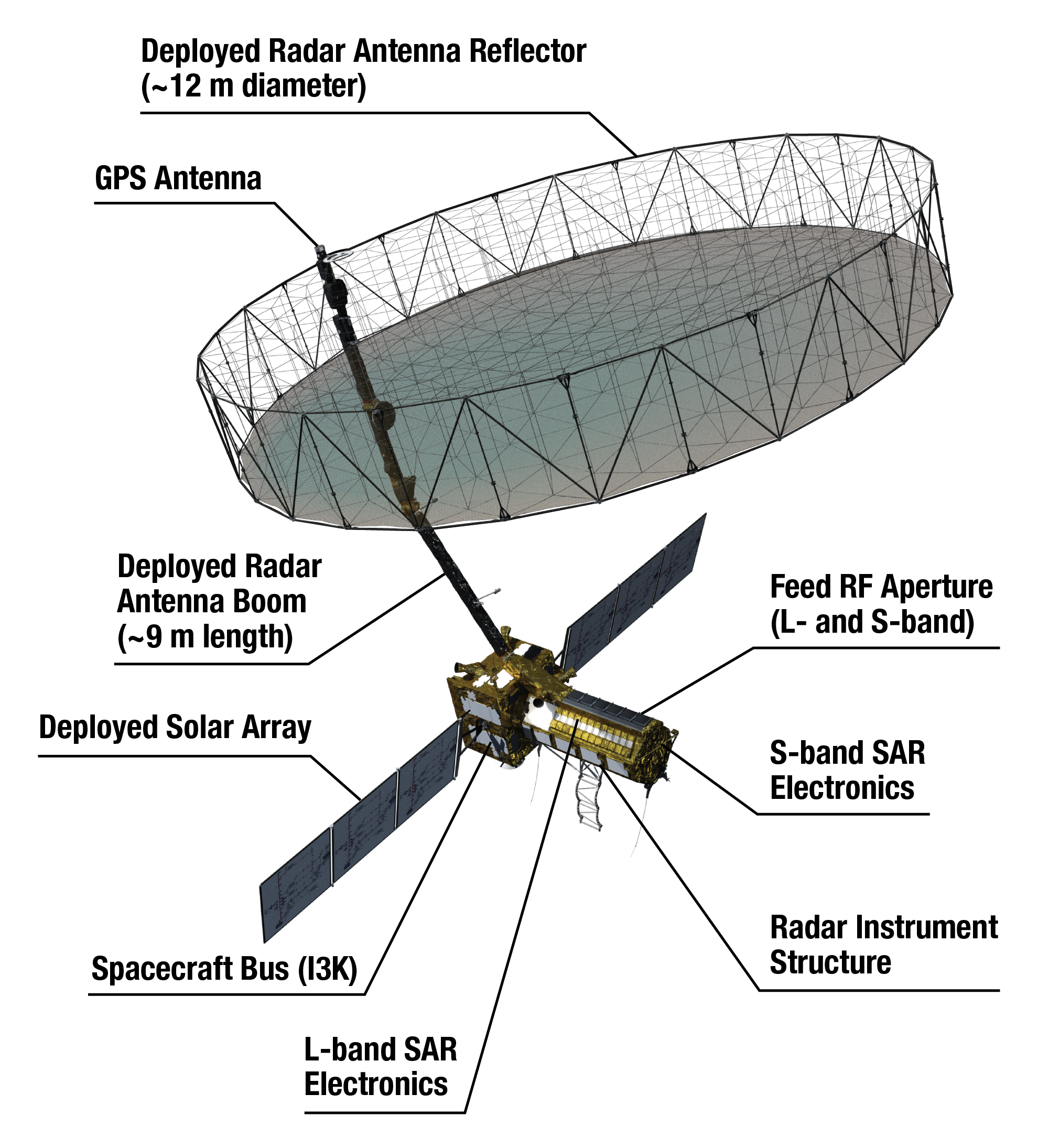NISAR is a satellite mission that stands for NASA-ISRO Synthetic Aperture Radar. It is a joint project between NASA and ISRO, the space agencies of the United States and India, respectively. The mission aims to use two different radar frequencies to map Earth’s surface and interior, including movements, soil moisture, ecosystems and more.
Table of Contents
What is SAR (Synthetic Aperture Radar)
Synthetic aperture radar (SAR) is a technique that uses radar waves to create high-resolution images of the Earth’s surface. Radar waves are electromagnetic waves that can penetrate clouds, dust, smoke and vegetation, unlike optical or infrared sensors that rely on sunlight or thermal radiation.
SAR works by sending pulses of radar waves from a satellite or an aircraft to the ground and measuring the time and angle of the reflected waves. By combining multiple pulses from different positions, SAR can create a synthetic aperture that is much larger than the physical antenna, resulting in finer resolution and more detail.
What are the Benefits of NISAR

NASA-ISRO SAR will be the first satellite to use two different radar frequencies, L-band and S-band, to observe the Earth. Each frequency has its own advantages and limitations, depending on the type and size of the target, the surface roughness, the moisture content and the vegetation cover. By combining the two frequencies, NASA-ISRO SAR will be able to measure a wider range of changes and phenomena than either one alone.
Some of the benefits of NASA-ISRO SAR are:
- Monitoring Earth’s changing ecosystems, such as forests, wetlands, grasslands and croplands, and estimating their biomass, carbon stocks and biodiversity. NASA-ISRO SAR will provide information on the structure, composition and health of vegetation, as well as the impacts of human activities, natural disturbances and climate change on ecosystems.
- Measuring Earth’s dynamic surfaces, such as earthquakes, volcanoes, landslides, glaciers, ice sheets and sea level rise, and assessing their impacts on natural hazards, infrastructure and coastal communities. NASA-ISRO SAR will detect and quantify surface deformations, such as fault movements, volcanic inflation and deflation, landslide displacements and glacier velocities, and monitor their evolution over time.
- Mapping Earth’s soil moisture and groundwater, and providing information for water resources management, agriculture, drought and flood forecasting, and climate modeling. NASA-ISRO SAR will measure the amount and distribution of water in the soil and the subsurface, and track how it changes due to precipitation, evaporation, irrigation and extraction.
- Studying Earth’s crust and mantle, and improving our understanding of the tectonic processes, geothermal activity and mineral resources. NASA-ISRO SAR will image the structure and composition of the Earth’s interior, and reveal the patterns and mechanisms of crustal deformation, magmatic intrusion and extrusion, and thermal anomalies.
What are the Objectives of NISAR
The NASA-ISRO SAR mission has four main objectives, according to the official websites of NASA and ISRO:
- To develop and launch a dual-frequency (L and S band) SAR satellite in a sun-synchronous dawn-dusk orbit, with a 12-day repeat cycle and a 6-day average revisit time.
- To acquire global data sets of high-resolution SAR imagery and interferometry, covering the land and ice-covered regions of the Earth, for a baseline period of three years, with a possibility of extension up to five years.
- To generate and distribute standard and value-added data products and services to support scientific research and applications in various domains, such as natural hazards, water resources, ecosystems, cryosphere, solid Earth and climate change.
- To foster scientific collaboration and capacity building between NASA and ISRO, and the broader user community, through data sharing, joint analysis, workshops, working groups and other activities.
Launch of NISAR
NASA-ISRO SAR is planned to launch in 2024 from India’s Satish Dhawan Space Center in Sriharikota, India, into a near-polar orbit. NASA requires a minimum of three years of global science operations with the L-band radar, and ISRO requires five years of operations with the S-band radar over specified target areas in India and the Southern Ocean.
GSLV MK2

NISAR satellite will launch on GSLV MK2.GSLV MK2 is a rocket that can launch satellites into orbit around the Earth. It is made by Indian Space Research Organisation, the Indian space agency. GSLV MK2 has three stages and four strap-on boosters that use liquid and solid fuels. GSLV MK2 can carry up to 2,500 kg of payload to a geostationary transfer orbit, or up to 6,000 kg to a low Earth orbit.
How does NISAR help in agriculture?
NASA-ISRO SAR is a satellite mission that can help in agriculture by providing high-resolution images and data of the Earth’s surface, including crop growth, soil moisture, and land-use changes. NASA-ISRO SAR can monitor the development and health of crops, estimate their yield and biomass, and detect the effects of drought, flood, pests, and diseases. NASA-ISRO SAR can also provide information for water resources management, irrigation planning, and crop insurance.
How does NISAR help in disaster management?
NISAR is a satellite mission that can help in disaster management by providing high-resolution images and data of the Earth’s surface and interior, before and after natural disasters such as earthquakes, tsunamis, and volcanic eruptions. NASA-ISRO SAR can measure the extent and impact of these disasters, such as surface deformations, displacements, and damages, and assist in risk assessment, mitigation, and response. NASA-ISRO SAR can also monitor other factors that affect disaster management, such as soil moisture, groundwater, vegetation, and climate change.
What is the resolution of NISAR?
NISAR will use advanced radar imaging to map the elevation of Earth’s land and ice masses four to six times a month at resolutions of 5 to 10 meters. This is much higher than the resolution of existing SAR satellites, which range from 10 to 100 meters. NISAR will also have a swath width of about 240 km, which means it can cover a large area of the Earth’s surface in each pass3. NISAR’s high resolution and wide swath will enable it to capture fine details and changes of the Earth’s features and processes.
Can I use NISAR data for commercial purposes?
Yes, you can use NISAR data for commercial purposes. NISAR has an open data policy and the data from the mission will be made available to the global scientific community and the public after necessary post-launch sensor characterization, which is expected to be completed within 6 months of launch. You can access the NISAR data from the official websites of NASA and ISRO, or from other data portals that will be announced later.
How to Get Involved with NISAR?
NISAR is designed to serve a wide range of users and applications, from scientists and researchers to decision-makers and stakeholders. The NISAR team is actively engaging with the potential user community through workshops, working groups and other activities, to inform and expand the NISAR user base.





